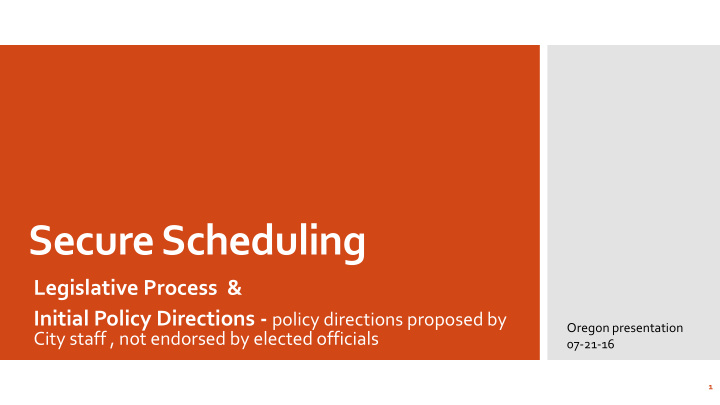



Secure Scheduling Legislative Process & Initial Policy Directions - policy directions proposed by Oregon presentation City staff , not endorsed by elected officials 07-21-16 1
Businesses don’t need the same amount of workers on a consistent basis. Workers bear the cost of the impact of resulting What is the irregular scheduling practices problem? Impacts include erratic schedules, unreliable incomes, involuntary part-time status, not enough time to rest between opening and closing shifts and coercion from employers to take shifts. 2
Balancing the need for predictability and flexibility Overall Goal for Policy for both workers and businesses 3
March through August 2016 Legislative Process – Mayor’s Office and City Council Staffing - Collaborative team with staff from Mayor’s Office, City Council and Office of Labor Standards National and local research Susan Lambert, Lonnie Golden, CLASP, and others Legislative and Seattle scheduling study by Vigdor Measurement & Stakeholder Evaluation, LLC Process Stakeholder Input – Worker Advocates & Business 8 separate meetings; 1 combined meeting Additional meetings with business & workers City Council Meetings Reports from stakeholder meetings Discussion of national and local research 4
Employer Large food services and drinking places and Coverage retail establishments 5
Written good faith estimate Provided upon hire and may revise on Good Faith quarterly basis or when employee has Estimate of exercised right to request a predictable, stable or flexible schedule Hours Requirement for English and primary language spoken by employees 6
Timing - At-hire, quarterly and at a major life event Request - Employees can request preferences/needs for a range of scheduling options Right to Employer Response Request Timely, Good faith consideration (i.e. worker Interactive dialogue input into Heightened standard for requests caregiving, second job, or educational purposes. Request must schedule) be granted unless bona fide reason/interferes with business operation Written response 7
Advance Two weeks (14 calendar days) Notice of Schedule 8
Minimum 10 hours between closing and opening shift Written employee consent for shifts separated Right to Rest by less than 10 hours Employee gets 1.5x hourly wage for hours that make shift separated by less than 10 hours. 9
Compensation for employees who have hours Predictability added or subtracted from the established Pay schedule. Exceptions 10
Options Any change to established schedule that results in additional hours Additional pay at regular rate One hour of pay for any additions, or Predictability Employers must use “availability list” for Pay - additions Additions No predictability pay for additions using availability list One hour of pay for additions not using availability list 11
Options Cancellation, change to dates or times that result in a loss of hours, phasing (i.e. employees leave before end of shift) Predictability Additional pay at regular rate Pay - .5x length of the shift or remainder of shift, or Subtractions .5x length of the shift, unless .5x the length of the shift was already worked, or 4 hours of pay or hours already worked, whichever is less 12
Compensation for employees who are scheduled on-call hours and are not asked to report to work Additional pay at regular rate Options On-Call Shifts .5x the length of the scheduled, on-call shift, or 4 hours of pay for shifts scheduled for 4 or more hours and 2 hours of pay for shifts scheduled for less than 4 hours 13
Employer must offer additional hours to existing employees before hiring externally Ability to post internally and externally concurrently Minimum 3 days for posting (physical and electronic distribution) Employee has 2 days to accept offer Access to Only whole shifts can be distributed; no requirement to parcel Hours hours Must offer hours to qualified candidate Exceptions: Participation in Diversity and Young Adult Hiring Program (bona- fide, written or partnership with government entity or non-profit organization) 14
Recommend
More recommend